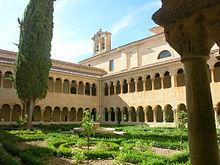
The monastery dates back to the Visigoth period of the 7th century. Back in the 10th century, the abbey was called San Sebastián de Silos, but acquired its current name when Santo Domingo was entrusted to restore the abbey into the Romanesque church that it is today. After being assigned to renovate the abbey by Fernando the Great, King of Castile and León, the abbot designed the church to have a central nave with two side aisles and five chapels attached to its apse and transept. When Santo Domingo died in 1073, work on the church and the cloister was handed over to Abbot Fortunius, who saw the rest of the construction to its completion.
The cloisters are the only surviving part of the monastery that hasn’t changed since its inception. The cloister is an angled rectangular shape with 16 semi-circular arches on the north and south sides and 14 semi-circular arches on the west and east sides. The lower story was begun during the last quarter of the 11th century and completed in the second half of the 12th century. The lower story’s date derives from an epitaph of the eponymous Santo Domingo, who died in 1073, which is located on the abacus of a group of four capitals in the north gallery. The cloister was dedicated on September 29, 1088. Additionally, the upper story of the cloister, which was placed upon the wooden vaulting of the first story, was completed during the 12th century.

Abbot Domingo’s successor, Abbot Fortunius was in charge of the construction of the north gallery and the original west gallery. After completion of two of the galleries and the beginning stages of construction of a third gallery, Fortunius was forced to halt construction on the cloister due to the influx of pilgrims coming to visit Abbot Domingo’s shrine. Additionally, construction on the cloister was halted for several decades because of political and economic difficulties during the period of 1109 to 1120. As a result of this interruption, it is clear that the west and south galleries are of a different style than the east and north galleries, which seem to indicate that a second, different workshop was hired after the intermission in construction to finish the work on the cloister.

The organization of the cloister consists of four squared-off piers at each corner and paired columns running along each of the arcades. The arcades are mounted atop a podium that extends along each side of the cloister. Each of the sides of the cloister has a grouping of four columns located at the center of the arcade. The six-foot-tall piers have medium-relief sculptural biblical scenes of the Post-Passion which are the Three Marys Discovering Jesus Christ is Gone, the Pentecost, the Doubting Thomas, and the Road to Emmaus. Originally, these religious scenes were painted in bright colors. These pier carvings are dated to the middle of the twelfth century and are the work of the sculptor of the lower story capitals. The southeast corner’s pier relief depicts the Ascension and the Pentecost. The northeast corner’s pier relief depicts the Entombment and the Descent from the Cross. The northwest corner’s pier relief depicts the disciples of Emmaus. The southwest corner’s pier reliefs depict the Annunciation to Mary and the Tree of Jesse.
The paired columns along each side of the cloister each share a capital. Each capital’s decoration is unique, and they contain a variety of animals, foliage or an abstract design. Due to the later date of their creation, the capitals on the second story of the cloister depict narrative scenes. All of the east gallery’s capitals and most of the capitals in the north gallery were carved by the same sculptor. The east gallery was the first to be finished, and it was followed by the completion of the north gallery. After intermission of construction on the cloister, work was resumed in 1158. The south gallery was completed soon after, and the newly reconstructed west gallery was the last side of the cloister to be finished. Before the west gallery was completed, plans were made to construct the second story of the cloister. It is believed that the lower story’s sculptural style is of better quality than that of the upper story.[1]
Monasterio de Santo Domingo de Silos
- ^ Whitehill, Jr., Walter Muir. “The Destroyed Romanesque Church of Santo Domingo de Silos.” The Art Bulletin 14, no. 4 (1932): 316-341.
